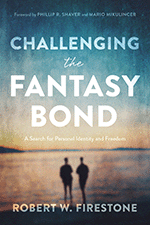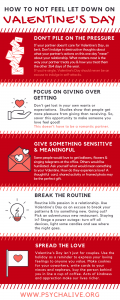A Guide to the Fantasy Bond
 Many struggles we face in our current interpersonal relationships arise from a core defense formed in childhood known as the “fantasy bond.” Maybe you’re wondering why you’re losing the “spark” between you and your partner or why you can’t seem to stop worrying about your kids. You may be surprised to learn that what’s really at the root of these frustrating dynamics is a fantasy bond. As the central concept of my father, Dr. Robert Firestone’s, theory, the fantasy bond describes an illusion of fusion we originally form with our parent or primary caretaker. This fantasy of being at one with our caretaker acts as a defense, helping relieve anxiety and emotional pain at times of distress. However, as we grow up, this very defense system limits our ability to pursue or accept real love and connection. Understanding this defense can be life-changing. Here, I share a brief guide to the fantasy bond that can shed light into how this type of bond forms, goes on to limit our lives, and how we can takes steps to break free of the destructive elements of our current relationships.
Many struggles we face in our current interpersonal relationships arise from a core defense formed in childhood known as the “fantasy bond.” Maybe you’re wondering why you’re losing the “spark” between you and your partner or why you can’t seem to stop worrying about your kids. You may be surprised to learn that what’s really at the root of these frustrating dynamics is a fantasy bond. As the central concept of my father, Dr. Robert Firestone’s, theory, the fantasy bond describes an illusion of fusion we originally form with our parent or primary caretaker. This fantasy of being at one with our caretaker acts as a defense, helping relieve anxiety and emotional pain at times of distress. However, as we grow up, this very defense system limits our ability to pursue or accept real love and connection. Understanding this defense can be life-changing. Here, I share a brief guide to the fantasy bond that can shed light into how this type of bond forms, goes on to limit our lives, and how we can takes steps to break free of the destructive elements of our current relationships.
How Fantasy Bonds Develop
 The fantasy bond is a primitive defense mechanism that we developed in early childhood as a way of maintaining an illusion of safety and security at those times when we experienced overwhelming frustration, hurt, or even terror. Infants have a natural ability to comfort themselves by using images and memories of past feeding experiences to ward off the anxiety of being temporarily separated from their mothers. Fantasy helps reduce feelings of hunger and frustration. The child’s illusion of connection compensates or substitutes for inadequacies in the early environment. In an attempt to cope with the emotional pain and restore a feeling of comfort, infants merge with their primary caretaker (often the mother) in their imagination, magically believing they are one with that person – feeling like the all powerful parent and the helpless infant, all in one. This fantasy of being connected to another can give a child an illusion of safety, even immortality, which later helps him or her cope with existential realizations and fears.
The fantasy bond is a primitive defense mechanism that we developed in early childhood as a way of maintaining an illusion of safety and security at those times when we experienced overwhelming frustration, hurt, or even terror. Infants have a natural ability to comfort themselves by using images and memories of past feeding experiences to ward off the anxiety of being temporarily separated from their mothers. Fantasy helps reduce feelings of hunger and frustration. The child’s illusion of connection compensates or substitutes for inadequacies in the early environment. In an attempt to cope with the emotional pain and restore a feeling of comfort, infants merge with their primary caretaker (often the mother) in their imagination, magically believing they are one with that person – feeling like the all powerful parent and the helpless infant, all in one. This fantasy of being connected to another can give a child an illusion of safety, even immortality, which later helps him or her cope with existential realizations and fears.
In our work, my father and I use the term fantasy bond to describe both the original imaginary connection formed during childhood and the repetitive efforts of an adult to continue to make these types of connections in interpersonal relationships. This kind of bond is also often extended beyond our parents, romantic partners, and children. In our quest for a sense of security, we may form a fantasy connection to:
- Siblings or other relatives
- Country
- Religion
- Work
- Sports team
- Social or political party
- Groups
How fantasy bonds continue to affect us
While people may be comfortable casually criticizing their parents as adults, as children, it may have felt scary to be critical of one’s caretakers. People rely on their parents for survival, and at times, a parent’s neglect or hostility might have felt terrifying, even life-threatening to the child. Part of the formation of a fantasy bond involves young children learning to self-parent, both soothing and punishing themselves in similar ways to the parent. Children identify with and internalize the ways the parent saw and treated them. They may try to preserve an idealized image of the parent by seeing themselves critically. As they grow up, they uphold an, often unconscious, internalized connection to their parent in the following ways:
- Idealizing their parents and family – i.e. “My parents were great. There was just something wrong with me.”
- Maintaining a negative image of themselves – Many people develop a “critical inner voice,” a negative thought process, which, like an internal parent, coaches, critiques, and comments on them, as they live our lives, i.e. “I’ve always been too much for other people to handle. No one could love me.”
- Projecting negative parental qualities and behaviors onto others – Without realizing it, we can project qualities of our parents onto the people we get close to throughout our lives. “She’s going to leave you. You can’t trust her.” “He’s critical of you. See how he looks at you.”
- Recreating negative family dynamics in adult relationships – People may choose to get close to others who remind them of their past. Or, they may distort, and even provoke, the people close to them to recreate old, familiar, albeit negative, dynamics.
- Reliving their parents’ life rather than living their own – Many people find it hard to differentiate and live their lives on their own terms. They continue to listen to the “voice” inside their heads that doesn’t always represent their real point of view.
- Maintaining psychological defenses that were adaptive as children but that limit them as adults – The psychological defenses someone formed in childhood to make them feel safe and secure are hard to shake later in life, even when these defenses are no longer adaptive. Defenses often go on to limit individuals in their lives and interpersonal relationships. For example, if they used to shut down to avoid punishment or would cling to the parent to get soothed, they may carry these patterns into their adult relationships, when they actually serve to create distance, rather than bring people closer.
Fantasy Bonds in Our Adult Relationships
 Though a fantasy bond is established early in life as a way to feel safe and connected, especially when one’s parents weren’t available or nurturing their needs, people go on to recreate these bonds in their adult relationships as a way to feel protected. As Dr. Robert Firestone wrote, “Most people have fears of intimacy and are self-protective and at the same time are terrified of being alone. Their solution to their emotional dilemma is to form a fantasy bond.” This bond replaces the substance of a loving relationship with the form of being a unit. It keeps people at a comfortable distance emotionally, while maintaining a sense of oneness with their partner that allows them to feel an, often false, sense of security.
Though a fantasy bond is established early in life as a way to feel safe and connected, especially when one’s parents weren’t available or nurturing their needs, people go on to recreate these bonds in their adult relationships as a way to feel protected. As Dr. Robert Firestone wrote, “Most people have fears of intimacy and are self-protective and at the same time are terrified of being alone. Their solution to their emotional dilemma is to form a fantasy bond.” This bond replaces the substance of a loving relationship with the form of being a unit. It keeps people at a comfortable distance emotionally, while maintaining a sense of oneness with their partner that allows them to feel an, often false, sense of security.
So, what interactions between a couple represent the difference between real love and a fantasy bond? As you look at these dynamics, remember that a fantasy bond exists along a continuum, and most of us fall somewhere on the spectrum in our relationships. Identifying that you and/or your partner have some of these behaviors doesn’t mean you should panic and throw away your relationship. Rather, realizing the degree to which you may relate in limiting ways can help you and your partner shift these dynamics and reestablish a loving connection.
Couple interactions that represent real love versus a fantasy bond:
- Being non-defensive and open vs angry and closed off
- Having respect for each other’s independence vs overstepping each other’s boundaries
- Expressing physical affection and personal sexuality vs a lack of affection and routine sexuality
- Understanding of who your partner really is vs misunderstanding and distorting your partner
- Engaging in non-controlling behaviors vs manipulations of dominance
Learn more about these characteristics here
Signs and symptoms you may be in a fantasy bond with your partner:
- Less eye contact
- Breakdown in communication
- Less affection and more impersonal or routinized lovemaking
- Loss of independence
- Speaking as one person
- Using everyday routines as symbols of closeness
- Utilizing role-determined behaviors as props in a fantasy bond
- Engaging in customs and conventional responses as substitutes for real closeness
Read more about these signs here
Steps to take to break a fantasy bond
 According to Dr. Robert Firestone, there are a number of steps that individual partners can initiate to break into the fantasy bond they have formed with each other. The following suggestions are adapted from his blog “The Fantasy Bond: A substitute for a truly loving relationship.”
According to Dr. Robert Firestone, there are a number of steps that individual partners can initiate to break into the fantasy bond they have formed with each other. The following suggestions are adapted from his blog “The Fantasy Bond: A substitute for a truly loving relationship.”
First, individuals in a couple have to acknowledge the existence of a fantasy bond. It will benefit them to stop denying that they have become distant and to admit that their actions are no longer loving. They can then move on to the following steps:
- Recognize feelings of anger and hostility as well as any critical attitudes they have toward themselves and their partner – Are they especially irritable with each other, picking each other apart and looking for fuel to be critical?
- Notice withholding patterns – Have they stopped doing things their partner loved or giving their partner attention?
- Face the psychological pain and sadness involved in attempting to reestablish intimacy – Challenging defenses and getting close to someone can make life more precious. It can also break fantasy connections from the past. If someone loves you in a way you never felt loved, for example, it forces you to face the pain of that initial hurt.
- Expose their fears of individuation and separation – A person may have to face that he or she has fear around becoming their own person. The false sense of security they get from a fantasy bond may not be available when they see themselves and the other person as independent individuals.
- Move toward independence and respect for each other/ Establish true equality – People have to disrupt any patterns of dominance, submission, and defiance in order to offer each other mutual respect and equality as well as genuine attraction.
- Develop a non-defensive posture toward feedback and an open and honest style of communication
- Move toward increased interaction with others – This involves extending a person’s social circle of family and friends, so they have additional support and perspectives.
Admittedly, the fantasy bond is a complex concept, with many facets to understand. However, seeking this understanding is a worthy pursuit, because it can truly change a person’s life and the way they relate to their loved ones. To learn more about the fantasy bond, why it develops, how it impacts our lives, and how we can challenge it, individuals and therapists can join me for the CE Webinar, “The Fantasy Bond.” Learn more here.
See more from the book Challenging the Fantasy Bond
 Tags: fantasty bond, fantasy love, relationship, relationship advice, relationship issues, relationship problems, relationships, The Fantasy Bond
Tags: fantasty bond, fantasy love, relationship, relationship advice, relationship issues, relationship problems, relationships, The Fantasy Bond










Hello,
I just purchased the Webinar for the Fantasy Bond today (13/8/20), but I have not received the email for the link or confirmation of purchase. Please advice.
Many thanks, Juita
Hi Juita, I have forwarded your message to someone who can help you resolve this issue. In the meantime, you may want to check your junk mail folder as these emails can sometimes get stuck there. Thanks for your interest in our webinar, and please let me know if I can help you with anything else!
I also nade a purchase 01/09/2021 , and i i don’t have receive any information from your ally the paypal receive, i iluso had send an email and try to contact your on Facebook and is the same no answers
No Order 23593
I have forwarded your request to someone who can assist you. They should be in contact with you shortly.